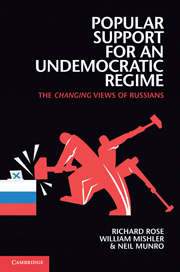Book contents
- Frontmatter
- Contents
- List of figures
- List of tables
- Introduction: The need for popular support
- 1 Democratic and undemocratic models of support
- 2 Changing the supply of regimes
- 3 Putin consolidates a new regime
- 4 Increasing support for an undemocratic regime
- 5 Individual influences on regime support
- 6 Time tells: there is no alternative
- 7 Finessing the challenge of succession
- 8 The challenge of economic reversal
- 9 Maintaining a regime – democratic or otherwise
- Appendix A New Russia Barometer samples
- Appendix B Coding of variables
- References
- Index
Appendix A - New Russia Barometer samples
Published online by Cambridge University Press: 05 June 2012
- Frontmatter
- Contents
- List of figures
- List of tables
- Introduction: The need for popular support
- 1 Democratic and undemocratic models of support
- 2 Changing the supply of regimes
- 3 Putin consolidates a new regime
- 4 Increasing support for an undemocratic regime
- 5 Individual influences on regime support
- 6 Time tells: there is no alternative
- 7 Finessing the challenge of succession
- 8 The challenge of economic reversal
- 9 Maintaining a regime – democratic or otherwise
- Appendix A New Russia Barometer samples
- Appendix B Coding of variables
- References
- Index
Summary
NRB surveys are conducted by the most senior and established not-for-profit survey research institution in Russia, the Levada Center, initially known as VCIOM, the Russian Center for Public Opinion Research. Its leading personnel are social scientists well versed in both the theory and practice of survey research (see www.levada.ru for details). Continuity in organization and personnel is especially beneficial for the long-term trend analysis reported in this book.
All New Russia Barometer surveys are conducted with multistage stratified samples. The starting point is the division of the population geographically across the whole of the Russian Federation except for war zones and difficult-to-reach extremities, areas with a small percentage of the national population. The data used for stratifying the population come from the censuses and official statistics collected by Goskomstat (www.gks.ru). Initially, the country is stratified into seven to ten large economic and geographical regions, and each is assigned a number of interviews proportionate to its share of the national population. All cities with more than 1 million population are selected, and within each region their center, towns and villages are selected with a probability proportionate to their population. Then, cities are stratified by ward and rural areas by villages in order to select Primary Sampling Units. An average of ten interviews is conducted in a sampling unit, thus ensuring a wide dispersion of interviews within big cities such as Moscow.
- Type
- Chapter
- Information
- Popular Support for an Undemocratic RegimeThe Changing Views of Russians, pp. 177 - 182Publisher: Cambridge University PressPrint publication year: 2011

